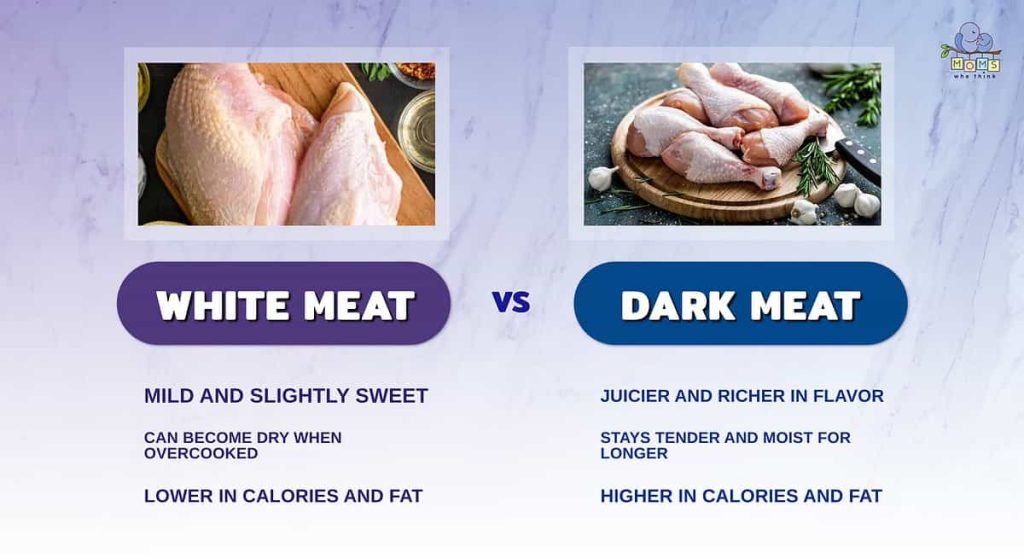The Great Chicken Soup Debate: Boneless vs. Bone-In and White Meat vs. Dark Meat
Chicken soup is more than just a comfort food; it’s a classic dish that can warm your heart and soul, especially on a chilly day or when you’re feeling under the weather. One of the key decisions when making chicken soup is choosing the right cut of chicken. Should you use boneless or bone-in? White meat or dark meat? These choices significantly impact the flavor, texture, and nutritional value of your soup. Let’s dive into the differences and discover how these decisions can transform your chicken soup from good to exceptional.
Boneless vs. Bone-In Chicken: Which is Better for Soup?
When making chicken soup, one of the first decisions is whether to use boneless or bone-in chicken. Here’s a closer look at each option:

Bone-In Chicken: Depth of Flavor and Richness
Using bone-in chicken, such as thighs, drumsticks, or even a whole chicken, brings a deep, rich flavor to your soup. The bones contain marrow, collagen, and connective tissues that release into the broth during cooking, enhancing the soup with a robust, savory taste and a slightly thicker texture. This is often why traditional chicken soups have a comforting, silky mouthfeel that’s hard to replicate with boneless chicken.
Benefits of Using Bone-In Chicken:
- Flavor Boost: The marrow and bones release natural flavors that deepen the taste of the broth, creating a more complex and savory soup.
- Nutrient-Rich: Bone-in chicken releases essential nutrients like calcium, magnesium, and collagen into the broth, which are beneficial for joint health, gut health, and immune support.
- Gelatinous Texture: The collagen from the bones dissolves into the soup, giving it a slightly thicker, more velvety texture that coats your spoon.
- Slow Cooking Perfection: Bone-in chicken is perfect for slow-cooking methods, allowing time for the flavors to meld beautifully. It’s an ideal choice for recipes where the soup simmers for hours, extracting every ounce of flavor from the bones.
However, using bone-in chicken does come with a couple of drawbacks. For one, it takes longer to cook, and you’ll need to remove the bones and skin before serving, which adds an extra step. This can be a bit messy, and for some, it’s an inconvenience.
Boneless Chicken: Convenience and Quick Preparation
Boneless chicken, whether it’s breast meat or thighs, offers a different set of advantages, particularly for those who prefer a quicker cooking process. Boneless chicken is easier to handle, cuts down on preparation time, and is perfect for those who want a leaner soup.
Benefits of Using Boneless Chicken:
- Ease and Convenience: Boneless chicken cooks faster, and there’s no need to deal with bones when serving, making it a more practical option for weeknight dinners.
- Healthier and Leaner: If you’re watching your calorie or fat intake, boneless, skinless chicken breasts are an excellent choice. They’re low in fat and high in protein, making the soup lighter.
- Customization: Boneless chicken allows you to easily dice or shred the meat, giving you more control over the texture and distribution of chicken throughout the soup.
- Quicker Cooking Time: Without the bones, the cooking time is significantly reduced, making it ideal for quick meals.
However, boneless chicken may lack the depth of flavor and richness that bone-in cuts provide. If using boneless chicken, you may need to boost the flavor with additional seasonings, herbs, or broth enhancers to achieve a similar richness.
White Meat vs. Dark Meat: What’s the Difference?
Once you’ve decided between boneless and bone-in, the next decision is between white meat (breasts) and dark meat (thighs and drumsticks). Each cut has distinct characteristics that can change the overall flavor and texture of your soup.

White Meat (Chicken Breasts): Light and Lean
White meat, primarily found in the chicken breast, is known for its lean, mild flavor and firm texture. It’s a popular choice for those seeking a healthier, lower-fat option in their soup.
Benefits of Using White Meat:
- Lower in Fat: Chicken breasts are significantly lower in fat and calories compared to dark meat, making them ideal for those on a calorie-conscious diet.
- Mild Flavor: The mild taste of white meat allows the other flavors of the soup, such as vegetables and herbs, to shine without being overpowered.
- Firm Texture: White meat retains a firm, slightly chewy texture that many people enjoy in their soup.
However, white meat can dry out quickly, especially if overcooked. It’s crucial to add it at the right time in the cooking process to prevent it from becoming tough. Also, because of its milder flavor, the broth may need extra seasoning to enhance the overall taste of the soup.
Dark Meat (Thighs and Drumsticks): Juicy and Flavorful
Dark meat, found in the thighs and drumsticks, is known for its richer flavor, juiciness, and tenderness. It contains more fat than white meat, which keeps it moist and flavorful during cooking.
Benefits of Using Dark Meat:
- Rich, Savory Flavor: Dark meat has a more intense flavor that adds depth to the soup. The higher fat content contributes to a luscious, full-bodied broth.
- Tender and Juicy: Dark meat stays tender even when simmered for long periods, making it perfect for soups that need to cook slowly.
- Higher Nutrient Content: Dark meat contains higher levels of iron, zinc, and B vitamins, adding extra nutritional value to your meal.
While dark meat is higher in fat, this also makes it more forgiving during the cooking process. It’s less likely to dry out compared to white meat, ensuring every bite remains tender and delicious.
Choosing the Right Combination for Your Perfect Chicken Soup
The best chicken soup depends on your personal preferences and dietary goals. For those seeking a rich, full-flavored broth with a comforting texture, bone-in dark meat is the way to go. If you prefer a lighter, healthier option that’s quick and easy to prepare, boneless white meat might be your best bet.
For a balanced approach, consider using a mix of both bone-in and boneless cuts or combining white and dark meat to create a soup that offers the best of both worlds. This way, you’ll enjoy the deep, savory notes from the bones and dark meat along with the lean, mild qualities of the white meat.
In the end, there’s no wrong way to make chicken soup. Whether you opt for bone-in thighs, boneless breasts, or a combination of both, the most important ingredient is the love and care you put into each simmering pot. So grab your ladle, choose your chicken, and let the comforting aroma of homemade chicken soup fill your kitchen.
4o

